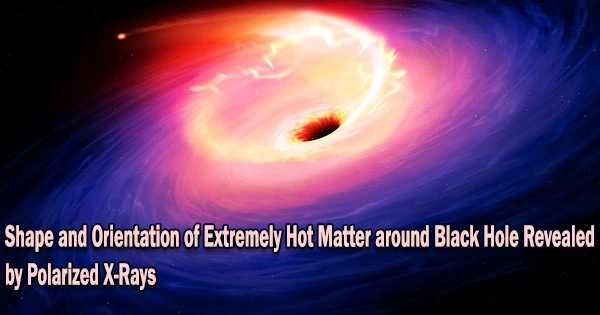Recent observations of the stellar-mass black hole Cygnus X-1 by researchers provide new information on the configuration of extremely hot materials in the black hole’s immediate vicinity.
As it is drawn in the direction of a black hole, it gets heated to millions of degrees. In X-rays, this heated stuff glows. Measurements of the polarization of these X-rays are being used by scientists to test and improve theories that explain how black holes consume matter to become some of the most brilliant sources of light, including X-rays, in the cosmos.
The new measurements from Cygnus X-1, published online by the journal Science on Thursday, Nov. 3, represent the first observations of a mass-accreting black hole from the Imaging X-Ray Polarimetry Explorer (IXPE) mission, an international collaboration between NASA and the Italian Space Agency (ASI). One of our galaxy’s brightest X-ray sources is Cygnus X-1, which consists of a companion star with a mass of 41 solar masses orbiting a black hole with a mass of 21 solar masses.
“Previous X-ray observations of black holes only measured the arrival direction, arrival time, and energy of the X-rays from hot plasma spiraling toward the black holes,” said lead author Henric Krawczynski, the Wayman Crow Professor of Physics in Arts & Sciences at Washington University in St. Louis and a faculty fellow in the university’s McDonnell Center for the Space Sciences. “IXPE also measures their linear polarization, which carries information about how the X-rays were emitted and if, and where, they scatter off material close to the black hole.”
Inside a black hole’s event horizon, no light can escape, not even X-ray light. The heated matter or plasma in a 2,000 km diameter zone encircling the black hole’s 60 km diameter event horizon is responsible for the X-rays discovered with IXPE.
The authors were able to restrict the geometry, or the shape and location of the plasma, in May and June 2022 by combining the IXPE data with concurrent observations from NASA’s NICER and NuSTAR X-ray observatories.
The IXPE mission uses X-ray mirrors fabricated at NASA’s Marshall Space Flight Center and focal plane instrumentation provided by a collaboration of ASI, the National Institute for Astrophysics (INAF), and the National Institute for Nuclear Physics.
Fabio Muleri
The scientists discovered that a two-sided, pencil-shaped plasma outflow, or jet, visible in prior radio measurements, is perpendicular to the plasma’s extension. The idea that the events in the X-ray bright region nearby the black hole play a major role in launching the jet is strongly supported by the alignment of the direction of the X-ray polarization and the jet.
The data is consistent with predictions that state the disk of matter spiraling into the black hole is either sandwiched by the corona of hot plasma or is completely replaced by it. Models, where the black hole’s corona is a slender plasma column or cone that extends down the jet axis, are ruled out by the new polarization data.
A deeper comprehension of the geometry of the plasma around a black hole, according to the researchers, can disclose a lot about the inner workings of black holes and how they accrete mass.
“These new insights will enable improved X-ray studies of how gravity curves space and time close to black holes,” Krawczynski said.
Related to the Cygnus X-1 black hole specifically, “IXPE observations reveal that the accretion flow is seen more edge-on than previously thought,” explained co-author Michal Dovčiak at the Astronomical Institute of the Czech Academy of Sciences.
“This may be a signature of a misalignment of the equatorial plane of the black hole and the orbital plane of the binary,” or the paired duo of the black hole and its companion star, clarified co-author Alexandra Veledina from the University of Turku. “The system may have acquired that misalignment when the black hole progenitor star exploded.”
“The IXPE mission uses X-ray mirrors fabricated at NASA’s Marshall Space Flight Center and focal plane instrumentation provided by a collaboration of ASI, the National Institute for Astrophysics (INAF), and the National Institute for Nuclear Physics,” said co-author Fabio Muleri of INAF-IAPS.
“Beyond Cygnus X-1, IXPE is being used to study a wide range of extreme X-ray sources, including mass accreting neutron stars, pulsars, and pulsar wind nebulae, supernova remnants, our galactic center, and active galactic nuclei. We’ve found a lot of surprises, and we’re having a lot of fun.”
A second paper in the same issue of Science was led by Roberto Taverna at the University of Padova and describes the IXPE detection of highly polarized X-rays from the magnetar 4U 0142+61.
“We are thrilled to be part of this new wave of scientific discovery in astrophysics,” Krawczynski said.





